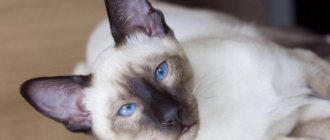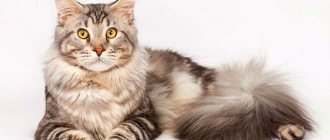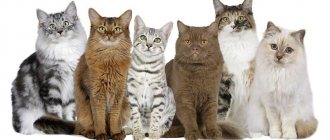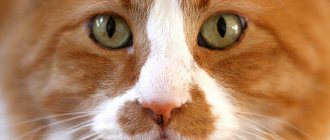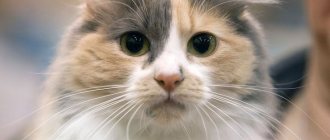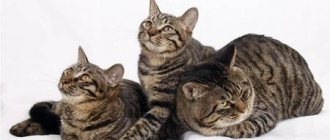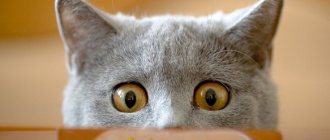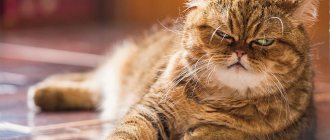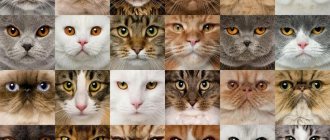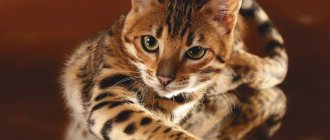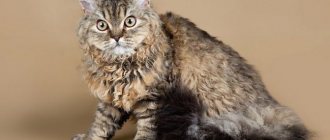What will you learn from the article?
- Shorthair cat breeds
- Semi-longhair cat breeds
- Long-haired cat breeds
- Hairless cat breeds
Fluffy and hairless, short-legged and long-legged, tailless and decorated with plumes - more than 100 breeds have already received official recognition, but literally every day new breeds of cats appear.
All cat breeds are divided into:
- Shorthair
- Semi-longhair
- Longhair
- Hairless cats
Shorthair cat breeds
Abyssinian cat
This cat breed is one of the most ancient. The Ethiopian beast (this is also the name of the beauty) is a cat of rare intelligence and rare obstinacy. The breed is famous for its exceptional colors - wild, red (sorrel or cinnamon), blue and fawn are characteristic of the Abyssinian. Ideally, each hair of her fur is triple ticked. Photos of the descendants of the cat Zula, the first Abyssinian brought to Europe, do not convey all the wild charm of the representatives of this breed.
Tipping
On average, when ticking, the hair is divided into 3 alternating zones. Tipping is a fairly close concept, but has two differences:
- Number of zones. Usually there are only two of them: light at the bottom and dark at the top.
- Mechanism of coloring. The lower part of the hair is lightened to white by complete or partial loss of pigment due to the dominant silver gene. In the first case, it becomes white, and in the second, yellow or apricot.
Depending on the degree of black coloration, several varieties are distinguished in this group. As with tabbies, the final color of a cat when tipped is determined by the presence of the agouti gene.
Haze and shaded
Haze and shaded colors are similar, but still separate varieties. In both places there is a dominant silver gene, but its manifestation depends on the agouti gene:
- Smoky
. Owners of this color carry the non-agouti allele in their chromosomes, which excludes the pattern. Because of this, the smoky coat of cats is often confused with a plain coat. The silveriness appears strictly when moving, when the hairs move apart and expose almost 50% of the white base.
- Shaded
. With this variety, only ⅓ of the hair is dyed. Due to the presence of the agouti gene, a pattern is formed on the fur coat, creating the effect of a translucent veil.
Depending on the color of the tips of the hairs, the haze can be blue, purple, black, chocolate and red. The presence of residual stripes in smoky colors is not allowed.
“ REFERENCE!
In addition to the standard haze, there is also a reverse haze, when it is not the base of the hairs that is painted white, but their ends.
Silver and gold
In this section, it is important to clarify that, unlike solids and tabbies, tipping is only a method of coloring. It is not a separate group of colors in cats. The color variations created by tipping are called silver. In addition to haze and shaded, 2 more colors are classified as silver:
- Silver tabby
. A unique option for zonal coloring with lightening of light areas to whiteness. The dark shade in this case retains its original color. Thanks to this, a pattern characteristic of a tabby appears on the body.
- Veiled, or chinchilla
. It is characterized by coloring only ⅛ of the hair. As with the ticked paint, the chinchilla will be disassembled separately just below.
Both varieties, like the shaded one, appear under the condition of the simultaneous presence of the silver and agouti genes. The first suppresses the production of both types of melanin, but has a greater effect on pheomelanin.
If there is an excess amount of red pigment (red and cream coat), its blocking fails. It gives a unique cameo color, when instead of dark tips, light ones are formed. As in the case of a chinchilla, the dyed part accounts for ⅛ of the total length of the hair.
“ NOTE!
The blue coat is often confused with the silver coat, but it still belongs to the solids. This confirms the absence of a white base in the hairs.
Unlike silver, gold consists strictly of red-yellow-orange colors. With this coloring, the color is preserved in both zones, but the upper one is painted more brightly and intensely. If the top layer accounts for ⅓ of the hair, then the color is called shaded gold, and if only ⅛, then veiled. In both cases, the golden cat is always green-eyed.
The golden color of the fur coat is the most expensive and rare. It is difficult to breed as the exact reason for its inheritance has not yet been identified. Mating of two golden individuals does not always give the desired result, since any inconsistency of genes leads to the suppression of pheomelanin.
Examples of breeds
The smoky color, like many others, is allowed by the American Curl standard. A brighter owner of the haze is the Australian mist, or Australian smoky. A silver coat is the calling card of the oriental beauty of Singapore, and bright gold is the most expensive color option for the chubby-cheeked “British”.
Chinchilla
With this color in cats, only the very tip of the hair is colored, and most of it remains white. The name “chinchilla” was given for a reason. The coat of animals with this color really resembles the fur of rodents or an arctic fox fur coat. An additional bonus is the extraordinary softness and fluffiness.
In addition to silver chinchillas, golden ones are also found. They are distinguished by a soft apricot undercoat. Regardless of the final color, all chinchillas have black eye and nose rims, black paw pads and bright green eyes.
Semi-longhair cat breeds
Balinese cat
These cats never grow to be giants; they are usually small or very small. The Balinese were born in Thailand, but this does not prevent them from communicating well with the whole world. You still have to look for such an open cat, striving to love and be loved!
Cymric
The Cymric cat comes from Canada. Some consider it a long-haired version of the Manx, but Canadians are sure that they have their own breed and it has the right to exist! Stocky, muscular and round are the main characteristics of the Cymric breed. They are also trainable and easy to bathe, as they simply adore water and water procedures.
Kurilian Bobtail
This is the Russian version of the short-tailed cat. The pom-pom tail, frost resistance and canine habits are the unofficial standard of the Kuril Bobtail breed. The length of the tail is different for each representative of the breed, traditionally varying from 2 to 8 vertebrae. The absence of a tail at all is a disqualifying sign.
LaPerm
Again a rex cat breed with wavy hair. Laperm is both American blood and oriental spices. In addition to curly hair, breeders note the silence of laperms. These are not the cats that wake you up in the morning with deep cries, but the ones that pull you out of your sleep with affectionate rubbing of the owner.
Munchkin
The Ulybaka cat is a munchkin cat. The length of its knife is three times shorter than the length of its body. A dachshund cat sometimes behaves like a kangaroo cat - it sits on its short hind legs and props up its body with a strong tail. Munchkins arrived in our open spaces only in 2001 and so far munchkins are not particularly popular.
Kurilian Bobtail – 5th place
The Kurilian Bobtail is a native of the Kuril Islands. The weight of this cat can be from seven to ten kilograms. One of the characteristics of the breed is its short tail, reminiscent of a pompom. These animals are friendly and inquisitive. With regular training, they can learn some commands.
Long-haired cat breeds
Himalayas
The Himalayan Colorpoint is very similar to the Persian cat, but the latter is never colorpointed. Another difference from the Persian cat is that the Himalayan cat is more active and playful. Long-haired cats get bored decorating the world with themselves and they are happy to run after a sunbeam.
Persian cat
Oh, the oldest and most popular! Yes, the creature, descended from the cat Scheherizade, must be treated with special respect. The snub-nosed cat lifts its nose for any reason and does not really like fuss around itself. According to the standard, there are about 100 varieties of Persian cat colors, but all these cats are similar in type of build - they are strong and massive.
History of Pied Pipers
The domestication of cats began in Ancient Egypt. People, seeing that these animals preyed on rodents eating food supplies, began to domesticate them. At that time, cats were sacred animals and they were fined for killing them. If a cat died in the house, people shaved their eyebrows as a sign of mourning. A good rat-catcher cat cost as much as an ox.
In Russia, cats performed the duty of catching rats from peasants, in the territories of monasteries and even in the royal palace. Sovereign Peter the Great ordered the adoption of cats to protect barns. By decree of Tsarina Elizabeth Petrovna, thirty rat catchers from Kazan were brought to the Winter Palace, since it was believed that the most skillful hunting cats lived there. During the reign of Empress Catherine the Great, cats were placed in the Hermitage to protect paintings and other valuables.
Ratcatcher cats help fight dangerous rodents
During the difficult years of the Great Patriotic War, cats saved Leningrad. When during the blockade all the animals in the city were eaten, houses and palaces were attacked by hordes of rodents. In 1943, 5 thousand cats arrived from Yaroslavl, and then another train of furry hunters from Siberia. Thanks to this, mice and rats quickly disappeared. To this day, fifty hunters, who are called “Hermitage cats,” live and work in the Hermitage in the status of Life Guards and museum employees.
General features and habits
The rat catcher is not an independent breed, but a valuable animal skill. Representatives of some breeds have a particularly keen hunting instinct.
Felinologists identify the following external signs of cats capable of catching a rat:
- large body, powerful jaws, strong paws;
- special triangular (oriental) head shape;
- thick vibrissae, large ears with tassels.
It is impossible to determine a rat trap by its character - some hunters are affectionate, some are unfriendly. Sometimes a cat, trying to please its owner, catches rats and brings them to the person as a sign of love and affection.
How to raise and care for hunters
Even if a kitten of the right breed has been chosen, this does not guarantee that it will become a rat catcher. The determining factor here is the behavior of his mother cat. If she hunts rodents, then the kitten will acquire the necessary skills from a very early age, and this is difficult to instill artificially.
You cannot separate a kitten from its mother too early, because only she can teach the baby to hunt. It is better to take an already strong fluffy at the age of 4-5 months.
When raising a future rat catcher, you need to adhere to the following rules:
- They will encourage the pet's love of hunting and praise it for catching a rodent.
- Don't starve your cat by trying to encourage him to hunt. A hungry animal will either run away or eat from neighbors or in a garbage dump.
- Monitor the physical shape and body weight of the purr, do not overfeed. It is recommended to feed 5-6 times a day, but in small portions.
- Get the required vaccinations, especially against rabies. This is important because during a fight with a rat, the rodent may bite the cat.
If your cat is scratched or bitten during the accident, you should contact a veterinarian to avoid developing rabies.
The animal must be vaccinated against rabies
